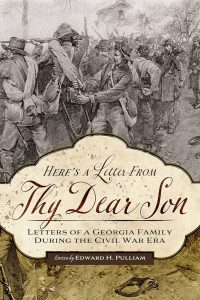Book Review: Here’s a Letter from Thy Dear Son: Letters of a Georgia Family during the Civil War Era

 Here’s a Letter from Thy Dear Son: Letters of a Georgia Family during the Civil War Era. Edited by Edward H. Pulliam. Macon: GA: Mercer University Press, 2024. Hardcover, 640 pp. $50.00.
Here’s a Letter from Thy Dear Son: Letters of a Georgia Family during the Civil War Era. Edited by Edward H. Pulliam. Macon: GA: Mercer University Press, 2024. Hardcover, 640 pp. $50.00.
Reviewed by Tim Talbott
During the American Civil War, family ties not only helped soldiers maintain distant connections with once very familiar people and places, relatives also often served as providers for some of the soldiers’ most basic needs when their governments were unable or unwilling to do so. Throughout the conflict, letter writing maintained and strengthened family bonds. Thousands of surviving letters bear evidence of senders’ and recipients’ shared dependence. In compiling and editing Here’s a Letter from Thy Dear Son: Letters of a Georgia Family during the Civil War Era, Edward H. Pulliam helps readers better understand the mutual relationship between those serving on the war’s battle lines and hospitals and those on the home front.
James H. and Thirza David’s union produced a wide family of letter writers. The Davids had emptied much of their nest by the beginning of the Civil War. They lived on their Jackson County (northwest of Athens) farm and had enslaved ten individuals, according to the 1860 census. Of their seven children, only two remained at home in 1861. Most of the others had married and had started their own families.
To help sort through the various individuals that the reader encounters throughout the book, Pulliam provides a helpful preface. It includes excellent background information on the early history of the north Georgia region where the Davids and their offspring lived. Also included in the preface are brief histories of the David family and the Jones and Bowen families (Thirza’s ancestors).
Although the letters contained in this large volume begin in 1847, the vast majority cover the Civil War years. Heard through their pages are the thoughts and feelings of matriarch Thirza, daughters Mary, Pillina, Pillona, and Ann, as well as Confederate officer sons Simeon, Owen, and Horatio, who all served in the Army of Northern Virginia. Also included are many letters from and to Manning Poole Alexander, who married Pillona and served as a doctor during the war in the Western Theater. The Davids lost their sons Simeon (killed in the battle of the Wilderness) and Owen (typhoid fever in October 1861). Horatio received wounds at Chancellorsville, and then near Front Royal in the fall of 1864, another wound cost him the sight in his right eye and basically ended his war. Particularly interesting are Thirza’s letters when she travels from Georgia to Richmond to nurse and bring Horatio home to recover following his Chancellorsville wound.
Readers are sure to appreciate Pulliam’s thorough editorial work, which comes through in several ways. Pulliam divides the book into three chronological parts: “Antebellum” (1847-1861), “Civil War” (1861-1865), and “After the War” (1865-1923). His chapter construction contains some overlap, but it serves the flow of the letters extremely well. The book’s typical structure in presenting the letters is to head it with the name of the letter writer, provide the transcription of the letter, and then offer “Notes” on the people, places, events, and terms contained within the letter that may not be familiar to readers. The Notes are then footnoted to show where Pulliam found his explanatory information. Placing the footnote citations on the same page as the Notes, instead of as endnotes, eliminates the need to continually flip to the back of the book.
In some places Pulliam also offers mini-biographies of people, as he does in Chapter 6, “War Approaches, June 1859-January 1861,” where he briefly describes the lives of Alexander Stephens, Herschel V. Johnson, Howell Cobb, and Robert Toombs and explains their significance. Pulliam also throws in various primary sources along the way for additional context. For example in the previously mentioned section, he includes the text of Georgia’s Ordinance of Secession. Likewise, for the campaigns and battles that receive coverage in the various letters, Pulliam takes the time and effort to summarize those actions for the reader’s benefit.
In addition to the letter writers noted above, letters from other family members, friends of the family, and comrades of Simeon and Horatio also are included. Although only mentioned sparingly throughout the book as individuals, we get the names of some of the people that the Davids enslaved with brief appearances in letters when news is shared, which only adds to the depth and importance of this truly fantastic published letter collection.
Here’s a Letter from Thy Dear Son: Letters of a Georgia Family during the Civil War Era would still make for a fine collection if it all it contained were just the letters. These missives are that rich. However, it is Pulliam’s editorial skills, and the excellent additional contextual information that he provides, that make this book more than just a collection of letters. It is a primary source exploration that is sure to be treasured by researchers, historians, genealogists, and Civil War enthusiasts, not only a valuable reference tool, but also an effective example for how to organize and present letter collections.